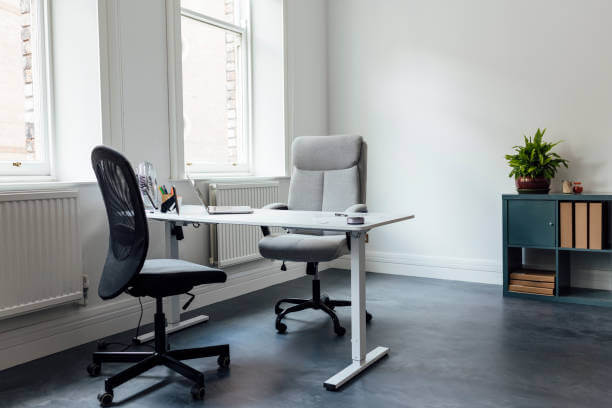Standing desks are a great way to stay active while working. They allow you to alternate between sitting and standing, which can help improve posture and overall health. But standing for long hours can also lead to fatigue and discomfort. That’s where “anti-fatigue mats” come in. These mats provide the support your body needs while standing, making your workday more comfortable.
In this article, we’ll explain why “anti-fatigue mats” are essential for your “standing desk” and how they can improve your health and productivity.
Why You Need Comfort with Standing Desks
Using a “standing desk” brings many benefits. It can reduce back pain, improve posture, and boost energy levels. However, standing for long periods can lead to discomfort, particularly in your feet, legs, and lower back. Without proper support, you might feel tired, sore, and unable to focus.
That’s where “anti-fatigue mats” come in. These mats provide a cushioned surface to stand on, reducing pressure on your feet and legs. The mat encourages small shifts in your posture, which helps keep blood circulating. As a result, you’ll feel more comfortable and energized throughout the day.
 What Are Anti-Fatigue Mats?
What Are Anti-Fatigue Mats?
Anti-fatigue mats are specially designed mats that cushion your feet and reduce pressure. Made from materials like polyurethane, foam, or PVC, they offer a soft, supportive surface for standing. These mats help reduce the strain on your feet, knees, and lower back, especially when you’re using a “standing desk” for long hours.
The mat’s surface compresses slightly as you stand, promoting subtle movement. This movement improves circulation and reduces muscle fatigue, making it easier to stand for longer periods.
Benefits of Anti-Fatigue Mats for Standing Desks
1. Increased Comfort
Standing on hard floors can be painful. **Anti-fatigue mats** provide cushioning to relieve pressure on your feet, legs, and lower back. This added comfort makes it easier to stand for long periods, whether you’re working, talking on the phone, or simply waiting.
2. Better Circulation
When you stand for too long, circulation can slow down, leading to discomfort. **Anti-fatigue mats** encourage subtle movements, like shifting your weight or slightly bouncing on your feet. These small actions keep your blood flowing, reducing the risk of swelling and fatigue.
3. Less Muscle Fatigue
Long hours of standing can lead to tired, aching muscles, especially in the lower back and legs. **Anti-fatigue mats** help by reducing pressure on your joints and muscles. This allows you to stand longer without feeling exhausted or uncomfortable.
4. Improved Posture
Posture is important when you’re standing for long periods. The right **anti-fatigue mat** can help support your feet and keep your body aligned. With the right setup, you can avoid slouching or leaning, which can lead to back pain. A good mat helps you maintain a natural, comfortable posture.
5. Boosted Productivity
Comfort plays a key role in productivity. When you’re not distracted by discomfort, you can focus better. **Anti-fatigue mats** help you feel more at ease while working, leading to better concentration and more effective work.
How to Choose the Right Anti-Fatigue Mat for Your Standing Desk
Selecting the best mat for your **standing desk** requires considering several factors. Here are some tips to guide your decision.
1. Material
The material of the mat affects both comfort and durability. Foam mats are soft and provide good cushioning, while polyurethane mats offer more support and durability. PVC mats are harder but offer excellent long-term durability. Choose a material that fits your needs for comfort and wear resistance.
2. Thickness
Thicker mats generally provide more cushioning, which can improve comfort. However, if a mat is too thick, it might affect your balance. Aim for a mat that provides enough cushioning to reduce strain without making it hard to maintain stability.
3. Size
The size of the mat should match the area where you stand most. A larger mat allows you to move around more freely. When choosing the size, consider the space available around your **standing desk** and how much area you typically use while standing.
4. Non-Slip Bottom
Safety is important when standing for long periods. A non-slip mat prevents the mat from sliding around on the floor. Look for mats with a rubberized or textured bottom to ensure it stays in place, even on smooth floors.
5. Durability
Since you’ll be standing on the mat regularly, durability is key. Choose a mat that’s made from high-quality materials and is designed to withstand frequent use. A durable mat will provide long-lasting comfort and support without losing its shape.
6. Easy to Clean
Standing desks can get messy. If you eat at your desk or have a high-traffic workspace, a mat that’s easy to clean is essential. Most mats can be wiped down with a damp cloth, but check the manufacturer’s cleaning instructions before making a choice.
Why Anti-Fatigue Mats Are Essential for Standing Desks
While **standing desks** are beneficial for reducing the risks of prolonged sitting, standing for long periods can still lead to fatigue and discomfort. **Anti-fatigue mats** are an essential addition to any **standing desk** setup. They help reduce strain on your body and promote comfort throughout your workday.
When used together, a **standing desk** and an **anti-fatigue mat** can provide the support you need to work more comfortably and efficiently. The right mat helps you stand for longer periods without feeling discomfort, allowing you to enjoy the full benefits of your **standing desk**.
Conclusion
A **standing desk** can greatly improve your posture and overall health, but standing for long hours can be hard on your body. By adding an **anti-fatigue mat** to your setup, you can enjoy better comfort, reduced fatigue, and increased productivity. These mats help support your feet, legs, and lower back while promoting better circulation and posture. If you want to get the most out of your **standing desk**, investing in a quality anti-fatigue mat is a must. Your body—and your work—will thank you.


 What Are Anti-Fatigue Mats?
What Are Anti-Fatigue Mats?